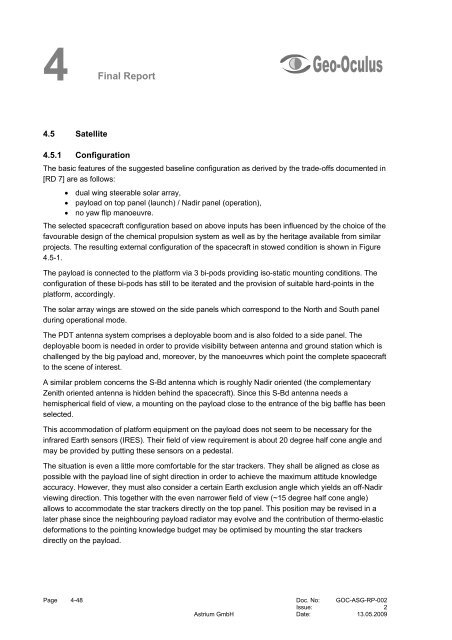4 Final Report - Emits - ESA
4 Final Report - Emits - ESA
4 Final Report - Emits - ESA
Create successful ePaper yourself
Turn your PDF publications into a flip-book with our unique Google optimized e-Paper software.
4 <strong>Final</strong><br />
4.5 Satellite<br />
<strong>Report</strong><br />
4.5.1 Configuration<br />
The basic features of the suggested baseline configuration as derived by the trade-offs documented in<br />
[RD 7] are as follows:<br />
• dual wing steerable solar array,<br />
• payload on top panel (launch) / Nadir panel (operation),<br />
• no yaw flip manoeuvre.<br />
The selected spacecraft configuration based on above inputs has been influenced by the choice of the<br />
favourable design of the chemical propulsion system as well as by the heritage available from similar<br />
projects. The resulting external configuration of the spacecraft in stowed condition is shown in Figure<br />
4.5-1.<br />
The payload is connected to the platform via 3 bi-pods providing iso-static mounting conditions. The<br />
configuration of these bi-pods has still to be iterated and the provision of suitable hard-points in the<br />
platform, accordingly.<br />
The solar array wings are stowed on the side panels which correspond to the North and South panel<br />
during operational mode.<br />
The PDT antenna system comprises a deployable boom and is also folded to a side panel. The<br />
deployable boom is needed in order to provide visibility between antenna and ground station which is<br />
challenged by the big payload and, moreover, by the manoeuvres which point the complete spacecraft<br />
to the scene of interest.<br />
A similar problem concerns the S-Bd antenna which is roughly Nadir oriented (the complementary<br />
Zenith oriented antenna is hidden behind the spacecraft). Since this S-Bd antenna needs a<br />
hemispherical field of view, a mounting on the payload close to the entrance of the big baffle has been<br />
selected.<br />
This accommodation of platform equipment on the payload does not seem to be necessary for the<br />
infrared Earth sensors (IRES). Their field of view requirement is about 20 degree half cone angle and<br />
may be provided by putting these sensors on a pedestal.<br />
The situation is even a little more comfortable for the star trackers. They shall be aligned as close as<br />
possible with the payload line of sight direction in order to achieve the maximum attitude knowledge<br />
accuracy. However, they must also consider a certain Earth exclusion angle which yields an off-Nadir<br />
viewing direction. This together with the even narrower field of view (~15 degree half cone angle)<br />
allows to accommodate the star trackers directly on the top panel. This position may be revised in a<br />
later phase since the neighbouring payload radiator may evolve and the contribution of thermo-elastic<br />
deformations to the pointing knowledge budget may be optimised by mounting the star trackers<br />
directly on the payload.<br />
Page 4-48 Doc. No: GOC-ASG-RP-002<br />
Issue: 2<br />
Astrium GmbH Date: 13.05.2009

















